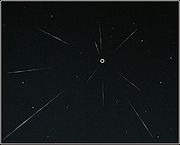.gif)
Radiant (meteor shower)
Encyclopedia
The radiant or apparent radiant of a meteor shower
is the point in the sky, from which (to a planetary observer) meteors appear to originate. The Perseids
, for example, are meteors which appear to come from a point within the constellation of Perseus
.
An observer might see such a meteor anywhere in the sky but the direction of motion, when traced back, will point to the radiant. A meteor that does not point back to the known radiant for a given shower is known as a sporadic and is not considered part of that shower.
and debris left in the wake of a comet
. This dust continues to move along the comet's wake, and when the Earth moves through such debris, a meteor shower results. Because all of the debris is moving in roughly the same direction, the meteors which strike the atmosphere all "point" back to the direction of the comet's path.
As an exception, the Geminids
are a shower caused by the object 3200 Phaethon
, which is thought to be a Palladian asteroid
.
 The radiant is an important factor in observation. If the radiant point is at or below the horizon
The radiant is an important factor in observation. If the radiant point is at or below the horizon
, then few if any meteors will be observed. This is because the atmosphere shields the earth from most of the debris, and only those meteors which happen to be travelling exactly (or very near) tangent
ial to the Earth's surface will be viewable.
Meteor shower
A meteor shower is a celestial event in which a number of meteors are observed to radiate from one point in the night sky. These meteors are caused by streams of cosmic debris called meteoroids entering Earth's atmosphere at extremely high speeds on parallel trajectories. Most meteors are smaller...
is the point in the sky, from which (to a planetary observer) meteors appear to originate. The Perseids
Perseids
The Perseids are a prolific meteor shower associated with the comet Swift-Tuttle. The Perseids are so-called because the point from which they appear to come, called the radiant, lies in the constellation Perseus. The name derives in part from the word Perseides , a term found in Greek mythology...
, for example, are meteors which appear to come from a point within the constellation of Perseus
Perseus (constellation)
Perseus is a constellation in the northern sky, named after the Greek hero Perseus. It was one of the 48 constellations listed by the 2nd century astronomer Ptolemy, and remains one of the 88 modern constellations defined by the International Astronomical Union...
.
An observer might see such a meteor anywhere in the sky but the direction of motion, when traced back, will point to the radiant. A meteor that does not point back to the known radiant for a given shower is known as a sporadic and is not considered part of that shower.
Cause
Meteor showers are mostly caused by the trails of dustDust
Dust consists of particles in the atmosphere that arise from various sources such as soil dust lifted up by wind , volcanic eruptions, and pollution...
and debris left in the wake of a comet
Comet
A comet is an icy small Solar System body that, when close enough to the Sun, displays a visible coma and sometimes also a tail. These phenomena are both due to the effects of solar radiation and the solar wind upon the nucleus of the comet...
. This dust continues to move along the comet's wake, and when the Earth moves through such debris, a meteor shower results. Because all of the debris is moving in roughly the same direction, the meteors which strike the atmosphere all "point" back to the direction of the comet's path.
As an exception, the Geminids
Geminids
The Geminids are a meteor shower caused by the object 3200 Phaethon, which is thought to be a Palladian asteroid. This would make the Geminids, together with the Quadrantids, the only major meteor showers not originating from a comet...
are a shower caused by the object 3200 Phaethon
3200 Phaethon
3200 Phaethon is an asteroid with an unusual orbit that brings it closer to the Sun than any other named asteroid . For this reason, it was named after the Greek myth of Phaëton, son of the sun god Helios...
, which is thought to be a Palladian asteroid
Pallas family
The Pallas or Palladian family of asteroids is a grouping of B-type asteroids at very high inclinations in the intermediate asteroid belt . It was first noted by Kiyotsugu Hirayama in 1928....
.
Observation

Horizon
The horizon is the apparent line that separates earth from sky, the line that divides all visible directions into two categories: those that intersect the Earth's surface, and those that do not. At many locations, the true horizon is obscured by trees, buildings, mountains, etc., and the resulting...
, then few if any meteors will be observed. This is because the atmosphere shields the earth from most of the debris, and only those meteors which happen to be travelling exactly (or very near) tangent
Tangent
In geometry, the tangent line to a plane curve at a given point is the straight line that "just touches" the curve at that point. More precisely, a straight line is said to be a tangent of a curve at a point on the curve if the line passes through the point on the curve and has slope where f...
ial to the Earth's surface will be viewable.

